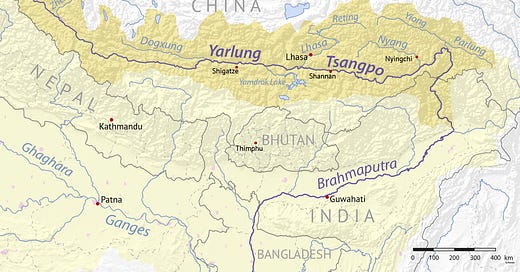Water Wars - Yarlung Tsangpo Dam
The Chinese Mega-Dam will be another source of conflict with India in their battle for regional hegemony.
(Credit: DEMIS Mapserver, map created by Shannon1)
Two of the world’s biggest dams (ranked by gigawatt output) are in China. If China delivers on its newly proposed dam on the Yarlung Tsangpo River in Tibet, China will hold #1,2 & 4 of the world’s top 5.
The scale of the project is of epic proportions, and will be the source of yet another geopolitical friction point with India. Western nations would take decades to plan, finance and build a project like this but as this is China, it will no doubt be delivered in an unfathomable timeframe. It will also likely involve the sort of labour and human rights violations that have been much criticised in the 200 odd hydroelectric projects to-date in Tibet, which is also a zone of significant geological activity (earthquakes - not known to be especially good for major dams!).
When it comes to rising to the challenges of the 21st century, projects like these are the sorts which detractors of liberal democracies point to, with all their annoying rules for environmental and human protection. Those same detractors would no-doubt be the first to complain if their home was flooded under a man-made lake to make way for the betterment of the national interest.
The dam itself is projected to produce - at around 60 gigawatts per year - three times the power of the world’s current largest dam, The Three Gorges (22.5 gigawatts per year). 300 million people in China are projected to receive power from the dam, although given its remote location in Tibet, far away from China’s population centres, how efficiently this power will be transmitted will remain to be seen.
The Itaipu Dam on the border of Brazil and Paraguay is the closest a dam in the Western hemisphere can come (14 gigawatts per year), followed by the Belo Monte Dam (11.2 gigawatts) and the Guri Dam in Venezuela (10.2 gigawatts). Despite Venezuela’s large and completely mismanaged hydrocarbon resources, that dam produces 34% of its electricity needs.
All hydroelectric projects have significant environmental impacts, albeit in harnessing one of the cleanest and most consistent sources of energy in the world. The Yarlung Tsangpo project will worry India (and Bangladesh) as a project significantly up steam which they can do little to prevent and which will disrupt the flow of the river (which becomes the Brahmaputra River in India), and which provides water for agriculture and drinking. It will also give China the ability to unleash huge amounts of water on its downstream neighbours.
Given the flow of major water courses near and between countries which already have points of friction, these will serve to be yet another conflict point in a world of scarce resources and mistrusting nations. Perhaps the most infamous of these is the Grand Ethiopian Renaissance Dam (GERD) which Egypt views as a major security challenge. Water supply was also a critical reason Russia was so anxious about the Crimea and Ukraine’s ability to control the water supply to it and its naval base at Sevastopol.
China and India, whatever association they have in the BRICS, are direct competitors for regional hegemony in Asia. While their shared border is remote, its also long (4,057 kms), and has been the site of major tensions in the past, including the brutal border clash in June 2020 along the contested ‘Line of Actual Control’.
India will be watching the development of this project hawkishly, and will be planning for a variety of security scenarios connected to it.
China - which has to import most of its oil, a critical strategic weakness - aims to increase its renewable energy consumption from 28.8% in 2020 to 33% this year. Projects like these will help to push it to and beyond 50%.
Water and energy, and the security issues which flow from both will increasingly be interrelated sources of tension and conflict across the world.




